标签:coder evel function 文件中 duplicate des param restrict params
为什么要学?
Scrapy_redis在scrapy的基础上实现了更多,更强大的功能。
有哪些功能体现?
request去重、爬虫持久化、实现分布式爬虫、断点续爬(带爬取的request存在redis中)、增量式爬虫(爬取过的生成指纹)
工作流程
先来看看之前的爬虫流程
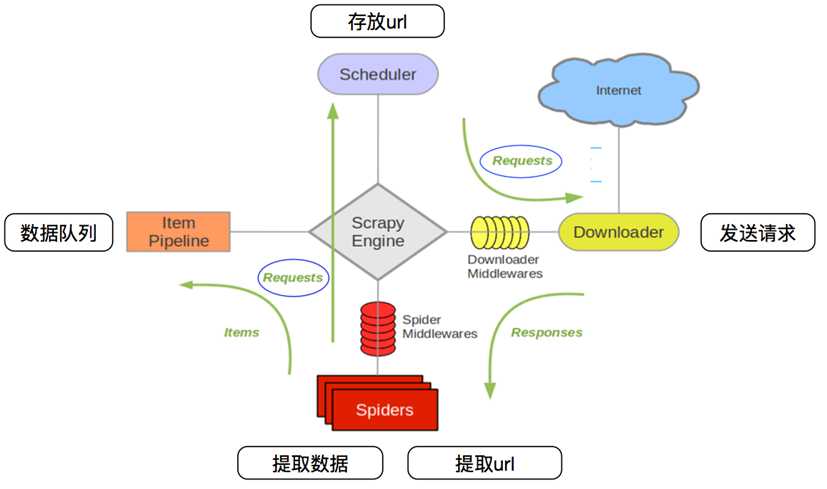
再来看看scrapy_redis的爬虫流程
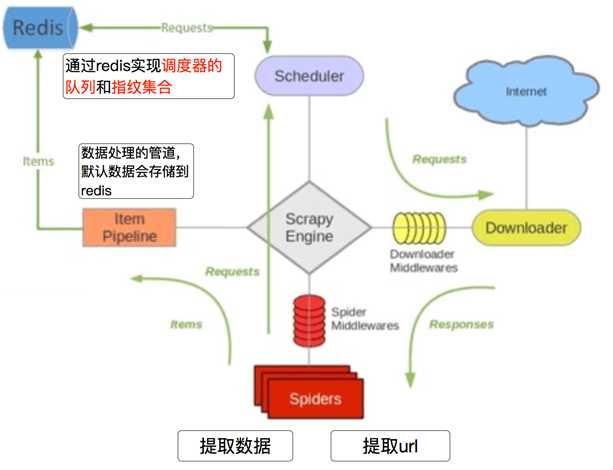
安装:
pip install scrapy-redis
源码包安装:
git clone git://github.com/rolando/scrapy-redis
官方文档在:https://scrapy-redis.readthedocs.io/en/stable/index.html#running-the-example-project
scrapy_redis 的源码在github:https://github.com/rmax/scrapy-redis
它提供了三个demo在example-projec/example中

三个案例有

先来看第一个案例:
dmoz.py
from scrapy.linkextractors import LinkExtractor from scrapy.spiders import CrawlSpider, Rule class DmozSpider(CrawlSpider): """Follow categories and extract links.""" name = ‘dmoz‘ allowed_domains = [‘dmoz.org‘] start_urls = [‘http://www.dmoz.org/‘] rules = [ Rule(LinkExtractor( restrict_css=(‘.top-cat‘, ‘.sub-cat‘, ‘.cat-item‘) ), callback=‘parse_directory‘, follow=True), ] def parse_directory(self, response): for div in response.css(‘.title-and-desc‘): yield { ‘name‘: div.css(‘.site-title::text‘).extract_first(), ‘description‘: div.css(‘.site-descr::text‘).extract_first().strip(), ‘link‘: div.css(‘a::attr(href)‘).extract_first(), }
这个案例很像我们自己写的crawlspider什么区别,所以接下来就要进行配置操作
先来看看官方的 Use the following settings in your project:
# 指定schedule队列 # Enables scheduling storing requests queue in redis. SCHEDULER = "scrapy_redis.scheduler.Scheduler" # 指定哪个去重方法给request对象去重 # Ensure all spiders share same duplicates filter through redis. DUPEFILTER_CLASS = "scrapy_redis.dupefilter.RFPDupeFilter" # Default requests serializer is pickle, but it can be changed to any module # with loads and dumps functions. Note that pickle is not compatible between # python versions. # Caveat: In python 3.x, the serializer must return strings keys and support # bytes as values. Because of this reason the json or msgpack module will not # work by default. In python 2.x there is no such issue and you can use # ‘json‘ or ‘msgpack‘ as serializers. #SCHEDULER_SERIALIZER = "scrapy_redis.picklecompat" # 队列中的内容是否持久保存,False:在关闭redis的时候清空redis # Don‘t cleanup redis queues, allows to pause/resume crawls. #SCHEDULER_PERSIST = True # Schedule requests using a priority queue. (default) #SCHEDULER_QUEUE_CLASS = ‘scrapy_redis.queue.PriorityQueue‘ # Alternative queues. #SCHEDULER_QUEUE_CLASS = ‘scrapy_redis.queue.FifoQueue‘ #SCHEDULER_QUEUE_CLASS = ‘scrapy_redis.queue.LifoQueue‘ # Max idle time to prevent the spider from being closed when distributed crawling. # This only works if queue class is SpiderQueue or SpiderStack, # and may also block the same time when your spider start at the first time (because the queue is empty). #SCHEDULER_IDLE_BEFORE_CLOSE = 10 # scrapy_redis实现的items保存到redis的pipeline # Store scraped item in redis for post-processing. ITEM_PIPELINES = { ‘scrapy_redis.pipelines.RedisPipeline‘: 300 } # The item pipeline serializes and stores the items in this redis key. #REDIS_ITEMS_KEY = ‘%(spider)s:items‘ # The items serializer is by default ScrapyJSONEncoder. You can use any # importable path to a callable object. #REDIS_ITEMS_SERIALIZER = ‘json.dumps‘ # 指定redis的地址 # Specify the host and port to use when connecting to Redis (optional). #REDIS_HOST = ‘localhost‘ #REDIS_PORT = 6379 # 指定redis的地址 # Specify the full Redis URL for connecting (optional). # If set, this takes precedence over the REDIS_HOST and REDIS_PORT settings. #REDIS_URL = ‘redis://user:pass@hostname:9001‘ # Custom redis client parameters (i.e.: socket timeout, etc.) #REDIS_PARAMS = {} # Use custom redis client class. #REDIS_PARAMS[‘redis_cls‘] = ‘myproject.RedisClient‘ # If True, it uses redis‘ ``spop`` operation. This could be useful if you # want to avoid duplicates in your start urls list. In this cases, urls must # be added via ``sadd`` command or you will get a type error from redis. #REDIS_START_URLS_AS_SET = False # Default start urls key for RedisSpider and RedisCrawlSpider. #REDIS_START_URLS_KEY = ‘%(name)s:start_urls‘ # Use other encoding than utf-8 for redis. #REDIS_ENCODING = ‘latin1‘
所以我们需要做的就是在配置文件中添加这几行
# 去重 DUPEFILTER_CLASS = "scrapy_redis.dupefilter.RFPDupeFilter" # 调度器 SCHEDULER = "scrapy_redis.scheduler.Scheduler" # 调度器持久化 SCHEDULER_PERSIST = True # 指定redis地址 REDIS_URL = "redis://192.168.226.150:6379" ITEM_PIPELINES = { ‘example.pipelines.ExamplePipeline‘: 300, ‘scrapy_redis.pipelines.RedisPipeline‘: 400, # 保存数据到redis }
在这里也贴上github上的settings:

# Scrapy settings for example project # # For simplicity, this file contains only the most important settings by # default. All the other settings are documented here: # # http://doc.scrapy.org/topics/settings.html # SPIDER_MODULES = [‘example.spiders‘] NEWSPIDER_MODULE = ‘example.spiders‘ USER_AGENT = ‘scrapy-redis (+https://github.com/rolando/scrapy-redis)‘ DUPEFILTER_CLASS = "scrapy_redis.dupefilter.RFPDupeFilter" SCHEDULER = "scrapy_redis.scheduler.Scheduler" SCHEDULER_PERSIST = True #SCHEDULER_QUEUE_CLASS = "scrapy_redis.queue.SpiderPriorityQueue" #SCHEDULER_QUEUE_CLASS = "scrapy_redis.queue.SpiderQueue" #SCHEDULER_QUEUE_CLASS = "scrapy_redis.queue.SpiderStack" ITEM_PIPELINES = { ‘example.pipelines.ExamplePipeline‘: 300, ‘scrapy_redis.pipelines.RedisPipeline‘: 400, } LOG_LEVEL = ‘DEBUG‘ # Introduce an artifical delay to make use of parallelism. to speed up the # crawl. DOWNLOAD_DELAY = 1
接下来我们就运行,跟往常的运行命令一样,切换到example 下,执行命令
\example>scrapy crawl dmoz
然后就去redis中查看

可以看到多了三个键
dmoz:items :存放获取到的item信息,在pipeline中开启RedisPipeline才会存入
dmoz:dupefilter :指纹集合,存放的是已经进入 scheduler 队列的 request 对象的指纹,指纹默认由请求方法,url和请求体组成
dmoz:requests :Scheduler队列,存放着待请求的 request 对象,获取的过程是pop操作,即获取一个会去除一个
三个键的类型:

以及数据
items

dupefilter

requests

如果我们不想把数据存放到redis,而是放到其他的地方,应该怎么做?
先来测试一下redispiipeline 关闭的情况
#ITEM_PIPELINES = { # ‘example.pipelines.ExamplePipeline‘: 300, #‘scrapy_redis.pipelines.RedisPipeline‘: 400, # 保存数据到redis #}
再看看redis数据库中这三个键如何变化,变化结果:
dmoz:requests 有变化(变多或者变少或者不变)
dmoz:dupefilter 变多
dmoz:items 不变
所以 redispipeline中仅仅实现了item数据存储到redis的过程,我们可以新建一个pipeline(或者修改默认的ExamplePipeline),让数据存储到其他地方。
接下来看一下 RedisPipeline 的源码段
from scrapy_redis.pipelines import RedisPipeline # 调用这个方法,实现数据的保存 def process_item(self, item, spider): # 调用一个异步线程去处理这个item return deferToThread(self._process_item, item, spider) def _process_item(self, item, spider): key = self.item_key(item, spider) data = self.serialize(item) # 向dmoz:items中添加item self.server.rpush(key, data) return item
去重的方法,通过生成指纹识别:指纹默认由请求方法,url和请求体组成
- 使用sha1加密request得到指纹 - 把指纹存在redis的集合中 - 下一次新来一个request,同样的方式生成指纹,判断指纹是否存在reids的集合中
- fp = hashlib.sha1()
- fp.update(request.method)
- fp.update(request.body or b"")
- fp.update(url)
- fp.hexdigest()
判断数据是否存在redis的集合中,不存在插入
added = self.server.sadd(self.key, fp) return added != 0
去重的的类 RFPDupeFilter :
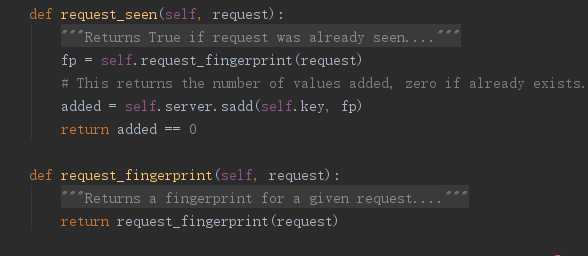
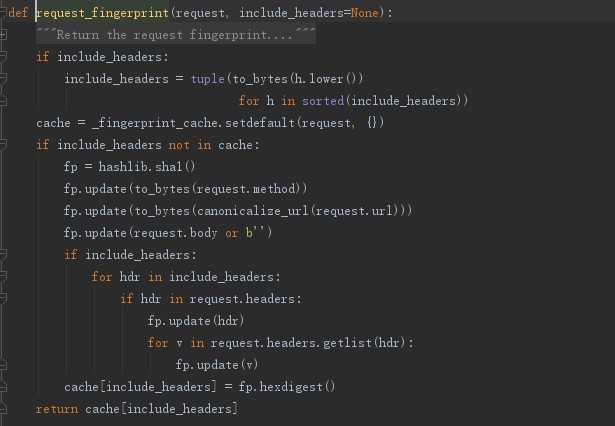
主要是这三个方法:
request_seen:判断requests对象是否已经存在,如果没有就添加到“dmoz:dupefilter”
request_fingerprint:调用函数request_fingerprint
request_fingerprint:主要是对请求进行加密生成指纹
下面来看看调度器:
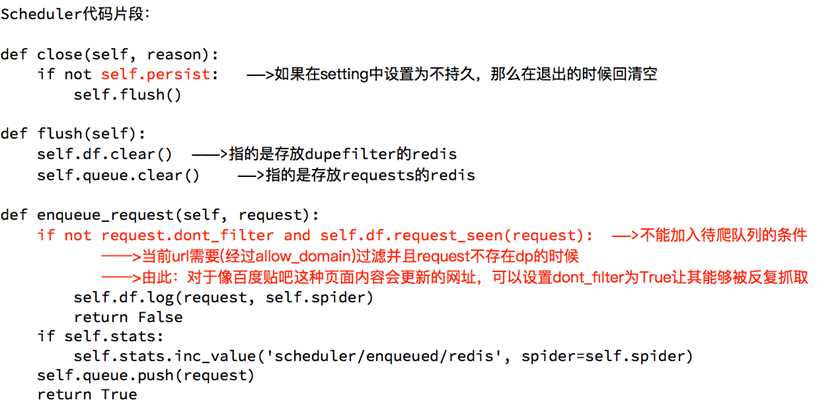
总结:
domz案例相当于之前的spider多了两个内容:
1、持久化
2、request去重的功能
通过源码以及setting中的配置来看,我们可以重写 去重 和 调度器的方法 ,还有存储数据的 pipeline 。在配置中改成我们重写的类就行。
标签:coder evel function 文件中 duplicate des param restrict params
原文地址:https://www.cnblogs.com/tangkaishou/p/10272546.html